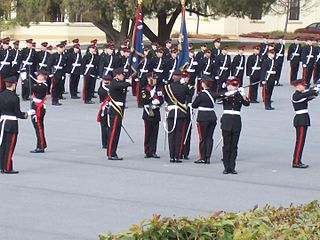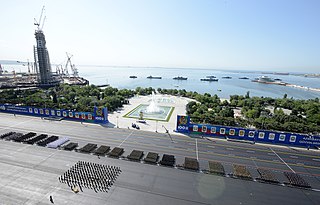
The Indonesian National Armed Forces are the military forces of the Republic of Indonesia. It consists of the Army (TNI-AD), Navy (TNI-AL), and Air Force (TNI-AU). The President of Indonesia is the commander-in-chief of the Armed Forces. In 2016, it comprises approximately 395,500 military personnel including the Indonesian Marine Corps, which is a branch of the Navy.

A military academy or service academy is an educational institution which prepares candidates for service in the officer corps. It normally provides education in a military environment, the exact definition depending on the country concerned.

The Korean People's Army is the de facto military forces of North Korea and the armed wing of the Workers' Party of Korea. Under the Songun policy, it is the central institution of North Korean society. Kim Jong-un is its Supreme Commander and the Chairman of the Central Military Commission. The KPA consists of five branches: Ground Force, the Navy, the Air Force, the Strategic Rocket Forces, and the Special Operation Force.

The Republic of Korea Armed Forces, also known as the ROK Armed Forces, are the armed forces of South Korea. The ROK Armed Forces is one of the largest standing armed forces in the world with a reported personnel strength of 3,699,000 in 2018. South Korea has one of the highest defense budgets in the world, ranking 10th globally in 2019, with a budget of more than $43 billion U.S. dollars. The South Korean military is ranked as the 7th most powerful military force in the world as of 2019.

The Turkish Armed Forces are the military forces of the Republic of Turkey. They consist of the Army, the Navy and the Air Force. The Gendarmerie and the Coast Guard, both of which have law enforcement and military functions, operate as components of the internal security forces in peacetime, and are subordinate to the Ministry of Interior. In wartime, they are subordinate to the Army and Navy. The President of Turkey is the military's overall head.
A general officer is an officer of high rank in the army, and in some nations' air forces or marines.

A commander-in-chief, also called supreme commander, is the person that exercises supreme command and control over an armed forces or a military branch. As a technical term, it refers to military competencies that reside in a country's executive leadership – a head of state or a head of government.
Officer Candidate School or Officer Cadet School (OCS) are institutions which train civilians and enlisted personnel in order for them to gain a commission as officers in the armed forces of a country. How OCS is run differs between countries and services. Typically, Officer Candidates are already Bachelor's Degree holders, and undergo a short duration of training which focuses primarily on military skills and leadership. This is in contrast with service academies which include academic instruction leading to a bachelor's degree.

A military band is a group of personnel that performs musical duties for military functions, usually for the armed forces. A typical military band consists mostly of wind and percussion instruments. The conductor of a band commonly bears the title of Bandmaster or Director of Music. Ottoman military bands are thought to be the oldest variety of military marching bands in the world, dating from the 13th century.

Many nations around the world observe some kind of Armed Forces Day to honor their military forces. It is celebrated in the United States as a day to appreciate all active duty service members. This day is not to be confused with Veterans Day or Memorial Day.
Wonsu is a high military rank in the armed forces of North Korea and South Korea.
The Comparative military ranks of Korea are the military insignia used by the two nations on the Korean Peninsula, those being the Republic of Korea Armed Forces and the Korean People's Army of the Democratic People's Republic of Korea. The United States Forces Korea personnel wear the ranks and insignia used by other service personnel of the United States Armed Forces in the territories of the United States.

A guard of honour (en-GB), also honor guard (en-US), also ceremonial guard, is a guard, usually military in nature, appointed to receive or guard a head of state or other dignitary, the fallen in war, or to attend at state ceremonials, especially funerals. In military weddings, especially those of commissioned officers, a guard, composed usually of service members of the same branch, form the Saber arch. In principle any military unit could act as a guard of honour. However, in some countries certain units are specially designated for guard of honour duty.
A military reserve force is a military organization composed of citizen-soldiers of a country who combine a military role or career with a civilian career. They are not normally kept under arms and their main role is to be available to fight when their military requires additional manpower. Reserve forces are generally considered part of a permanent standing body of armed forces. The existence of reserve forces allows a nation to reduce its peacetime military expenditures while maintaining a force prepared for war. It is analogous to the historical model of military recruitment before the era of standing armies.
The Order of Military Merit is the primary military decoration awarded by the South Korean government. It is awarded to a person who rendered "outstanding military services by participating in an action in time of war or in quasi-state of war or by performing his/her duty equivalent to combat, such as responding to the attack of an enemy in a contact area."
The army rank of captain is a commissioned officer rank historically corresponding to the command of a company of soldiers. The rank is also used by some air forces and marine forces. Today, a captain is typically either the commander or second-in-command of a company or artillery battery. In the Chinese People's Liberation Army, a captain may also command a company, or be the second-in-command of a battalion.

The Joint Chiefs of Staff of the Republic of Korea is a group of Chiefs from each major branch of the armed services in the South Korean military. Unlike the United States' counterpart which is primarily advisory, the Chairman of the Joint Chiefs of Staff has actual operational control over all military personnel of South Korea's armed forces. The National Command Authority runs from the President and the Minister of National Defense to the Chairman of the Joint Chiefs of Staff and then to Operational Commands of the service branches, bypassing the Headquarters of each service branch. Currently there are five Operational Commands in the Army, two in the Navy and one in the Air Force.
Major General is a military rank used in many countries. It is derived from the older rank of Sergeant Major General. The disappearance of the "sergeant" in the title explains the apparently confusing phenomenon whereby a Lieutenant General outranks a Major General while a Major outranks a Lieutenant.